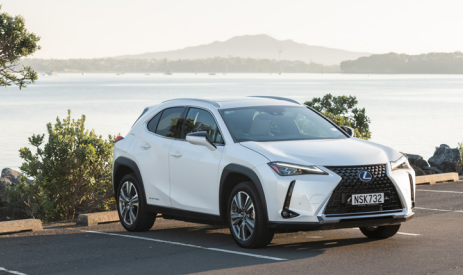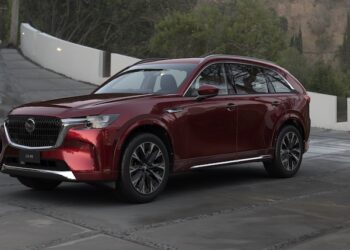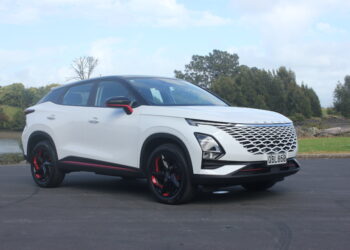
Lexus New Zealand has launched its first EV into the New Zealand market. Significantly, it’s also the first time parent brand Toyota has retailed a fully electric vehicle.
And it’s doing so in a few interesting ways, with a price that pitches the luxury UX300e against more mainstream offerings; and there’s an even less expensive version for fleets that retail customers can’t buy.
In another move that could be seen as disruptive, it’s dropping the standard charging lead included with virtually all new electric vehicles.
The first 100 customers can choose between a free lead or ChargeNet credit, but after that it may only be an option.
For those who fit a wallbox to their garage that could be seen as an admirable way to cut e-waste, for others it could be seen as cheap.
At $79,990 inclusive of on road costs, the UX300e Limited undercuts other luxury EVs like the Mercedes-Benz EQA and matches the entry-level Hyundai Ioniq 5.
It also undercuts some specification levels of the Hyundai Kona and Kia Niro.
Among its key competitors, only the Tesla Model 3 has a significant price advantage, though that applies in the case of the UX300e Limited.
It’s unclear how much the entry level Lexus will cost.
Lexus hopes half of the expected volume of 250 units will be transacted that way. So far, 90 vehicles are on their way.
Lexus general manager Andrew Davis hopes for a positive response to the car from government and fleets, though acknowledges it may not be the right image for some to be seen in a luxury model.
“Hopefully, positively, because it is a new channel for Lexus to operate in,” he says.
“It won’t be the EV for everyone from a government point of view.” But he believes the car will have broad appeal. “It’s attracting a conquest customer base for us,” Davis says. “If you’re considering EVs and in that price bracket you have to consider UX300e.
“We wanted to get in the Clean Car rebate zone, it opens up some possibilities.”
So what is Lexus NZ considering? The UX300e is largely unchanged from the hybrid models that have been popular since their launch about two years go.
The fleet grade car has 17-inch alloy wheels and the higher-spec Limited has 18-inchers.
The entry-level gets two NuLux synthetic leather options – White Ash and Black.
The Limited has leather options of Rich Cream, Ochre, and Zephyr Blue – all three are accented with Sashiko quilting on the front seats.
Both variants have front and rear seat heaters and front seat ventilation. The air conditioning system can be set to optimise efficiency while the front seat heating is on, improving power conservation.
The UX 300e has a 13-speaker Mark Levinson sound system coupled with a 10.3- inch display and Apple Car Play and Android Auto compatibility.
Other standard safety features include the complete Lexus Safety System +, blind spot monitor, parking support brake, and a tyre pressure warning system.
The Limited comes with roof rails, rear privacy glass, sunroof, rain sensing wipers, cornering lights, rear stabiliser bar, and a head-up display.
It also gets triple LED headlights with adaptive high-beam, and a hands-free power back door.
The drivetrain consists of a 150kW/300Nm electric motor driving the front wheels, with three selectable drive modes.
The 53kWh battery is temperature controlled. NEDC range – TNZ doesn’t have a WLTP rating for the car – is 340km, it can sprint to 100km/h in 7.5 seconds, and has a limited top speed of 160km/h.
What the vehicle lacks is charging capability. The UX worldwide features DC charging only by Chademo port – there is an AC charging type-two port on the other side of the vehicle.
Though ChaDeMo can be implemented up to 62.5kW, the UX is restricted to 50kW, giving it a 0-80% time of around 80 minutes.
Rivals the EQA will charge at up to 100kW and the Ioniq 5 at far higher depending on the model.
Chademo itself presents a different issue in congestion. Though ChargeNet’s current units can charge one car at a time, their new hypercharger installations favour CCS over Chademo two-to-one.
Therefore, the UX will be competing for spots with the huge fleet of Nissan Leafs.
The AC charging is also limited, at 6.6kW. Lexus representatives noted this was fine for single-phase systems fitted in homes, though it does overlook – and fails to take advantage of – destination chargers and public infrastructure.
However, they say they will continue to ask for 11kW charging as upgrades are rolled out.
With the UX launched online because of COVID restrictions, we’re yet to drive the car. But we’ll be one of the first to get it, so expect a review here soon.
BETTER THAN A COMPLIANCE CAR
At the time this magazine went to production, EVs and Beyond had managed a short drive in the UX300e.
Some critics might argue that the UX is a “compliance car”, a half-cooked attempt to meet regulations or simply enter the EV race.
The hallmarks are there: an unchanged design, a battery that hangs well below the vehicle, charging through the fuel flap, and little in the way of bespoke software or hardware that the ICE versions don’t have.
But like some, the UX outshines those points and in my opinion is better than the sum of its parts.
Yes, you can’t overcome the slow charging but it does well enough to be forgiven.
This is one of the nicest-driving small EV SUVs available.
The battery weight is well hidden by excellent suspension tuning, and the steering, though a little numb, feels responsive and perfectly weighted.
The brakes feel crisp for an EV, power delivery is ample, and throttle response well tuned.
I think this easily edges the EQA for driver experience, and also edges it in driver comfort and build quality.








